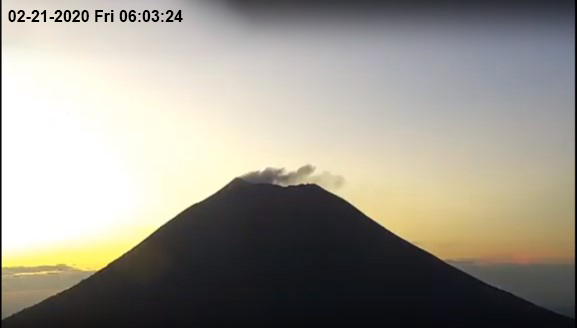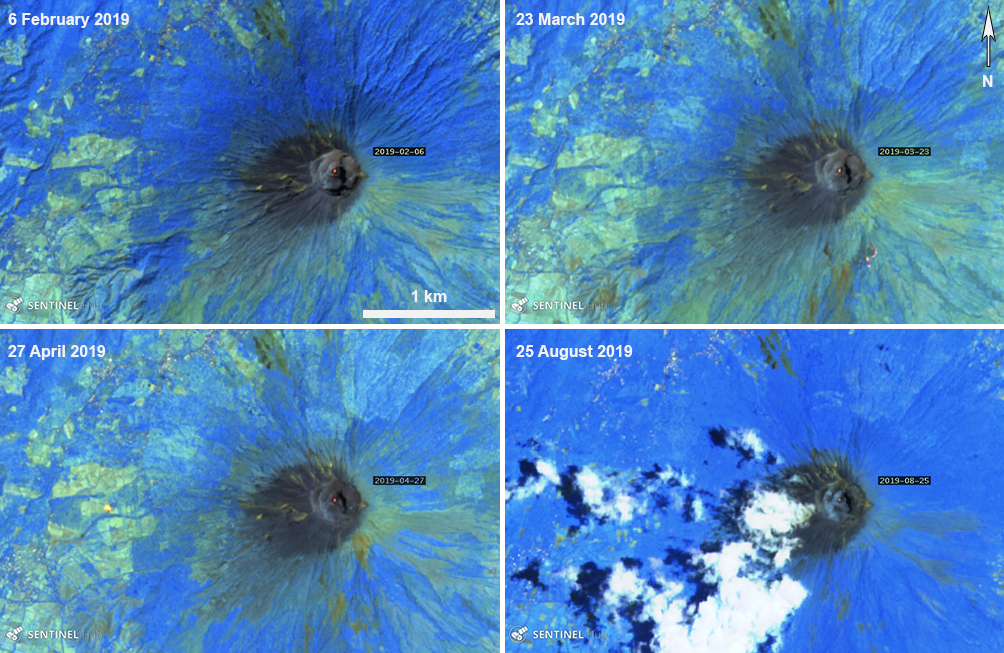Report on San Miguel (El Salvador) — March 2020
Bulletin of the Global Volcanism Network, vol. 45, no. 3 (March 2020)
Managing Editor: Edward Venzke.
Edited by Kadie L. Bennis.
San Miguel (El Salvador) Small ash emissions during 22 February 2020
Please cite this report as:
Global Volcanism Program, 2020. Report on San Miguel (El Salvador) (Bennis, K.L., and Venzke, E., eds.). Bulletin of the Global Volcanism Network, 45:3. Smithsonian Institution. https://doi.org/10.5479/si.GVP.BGVN202003-343100
San Miguel
El Salvador
13.434°N, 88.269°W; summit elev. 2130 m
All times are local (unless otherwise noted)
San Miguel, locally known as Chaparrastique, is a stratovolcano located in El Salvador. Recent activity has consisted of occasional small ash explosions and ash emissions. Infrequent gas-and-steam and ash emissions were observed during this reporting period of June 2018-March 2020. The primary source of information for this report comes from El Salvador's Servicio Nacional de Estudios Territoriales (SNET) and special reports from the Ministero de Medio Ambiente y Recursos Naturales (MARN) in addition to various satellite data.
Based on Sentinel-2 satellite imagery and analyses of infrared MODIS data, volcanism at San Miguel from June 2018 to mid-February was relatively low, consisting of occasional gas-and-steam emissions. During 2019, a weak thermal anomaly in the summit crater was registered in thermal satellite imagery (figure 27). This thermal anomaly persisted during a majority of the year but was not visible after September 2019; faint gas-and-steam emissions could sometimes be seen rising from the summit crater.
Volcanism was prominent beginning on 13-20 February 2020 when SO2 emissions exceeded 620 tons/day (typical low SO2 values are less than 400 tons/day). During 20-21 February the amplitude of microearthquakes increased and minor emissions of gas-and-steam and SO2 were visible within the crater (figure 28). According to SNET and special reports from MARN, on 22 February at 1055 an ash cloud was visible rising 400 m above the crater rim (figure 29), resulting in minor ashfall in Piedra Azul (5 km SW). That same day RSAM values peaked at 550 units as recorded by the VSM station on the upper N flank, which is above normal values of about 150. Seismicity increased the day after the eruptive activity. Minor gas-and-steam emissions continued to rise 400 m above the crater rim during 23-24 February; the RSAM values fell to 33-97 units. Activity in March was relatively low; some seismicity, including small magnitude earthquakes, occurred during the month in addition to SO2 emissions ranging from 517 to 808 tons/day.
 |
Figure 28. Minor gas-and-steam emissions rising from the crater at San Miguel on 21 February 2020. Courtesy of Ministero de Medio Ambiente y Recursos Naturales (MARN). |
 |
Figure 29. Gas-and-steam and ash emissions rising from the crater at San Miguel on 22 February 2020. Courtesy of Ministero de Medio Ambiente y Recursos Naturales (MARN). |
Geological Summary. The symmetrical cone of San Miguel, one of the most active volcanoes in El Salvador, rises from near sea level to form one of the country's most prominent landmarks. A broad, deep, crater complex that has been frequently modified by eruptions recorded since the early 16th century caps the truncated unvegetated summit, also known locally as Chaparrastique. Flanks eruptions of the basaltic-andesitic volcano have produced many lava flows, including several during the 17th-19th centuries that extended to the N, NE, and SE. The SE-flank flows are the largest and form broad, sparsely vegetated lava fields crossed by highways and a railroad skirting the base of the volcano. Flank vent locations have migrated higher on the edifice during historical time, and the most recent activity has consisted of minor ash eruptions from the summit crater.
Information Contacts: Servicio Nacional de Estudios Territoriales (SNET), Ministero de Medio Ambiente y Recursos Naturales (MARN), Km. 5½ Carretera a Nueva San Salvador, Avenida las Mercedes, San Salvador, El Salvador (URL: http://www.snet.gob.sv/ver/vulcanologia); Sentinel Hub Playground (URL: https://www.sentinel-hub.com/explore/sentinel-playground).


